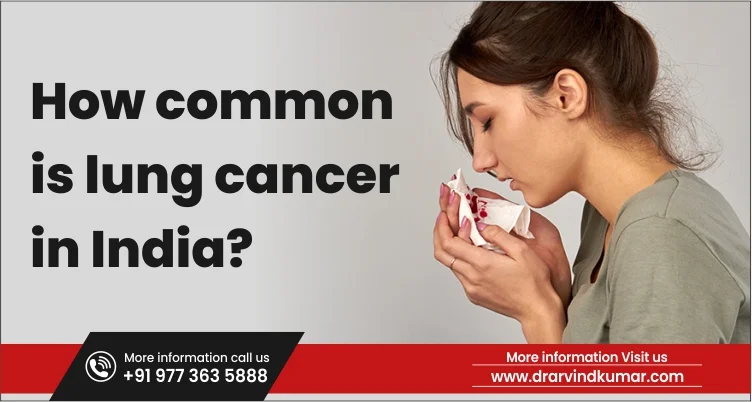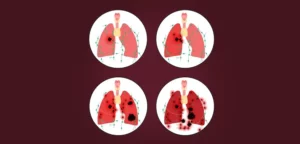In India, the number of lung cancer cases is increasing. According to specialists from the Indian Council of Medical Research (ICMR), lung cancer cases in Indiaare predicted to increase more than seven times by 2025 compared to the situation a decade ago.
Whats worse is that roughly 45% of lung cancer patients find out they have the disease when it has already spread to other body areas. Indians typically receive their diagnosis in their mid-50s, a decade sooner than the general population in the west. Poor outcomes result from lung cancer being discovered between stages 3 and 4 in 75% of cases. High death rates and low survival rates are observed in lung cancer in India.
28 population-based cancer registries and 58 hospital-based cancer registries provided the study with the cancer data. Between 2012 and 2016, they discovered records for 22,645 lung cancer patients. The study predicts a seven-fold increase in this figure to over 1.61 lakh in 2025, with an estimated 30,000+ cases among females and 81,000+ cases among males. In the most recent issue of the Indian Journal of Medical Research, the researchers stated that “rising occurrences and delayed diagnosis are of considerable concern.”
The researchers examined the lung cancer trend in five major cities with cancer registries that had been operational for the previous 40 years. In Delhi, Bengaluru, and Chennai, the number of male cases increased steadily between 1982 and 2016, whereas it decreased in Mumbai and Bhopal. In all cities besides Bhopal, its on the rise among women. The rise was driven by tobacco use and air pollution, both indoor and outdoor, even if the registries do not specify the causes. Exposure to secondhand smoke plays an equally significant role.
Major causes of lung cancer In India
India is the worlds second-largest consumer of tobacco and third-largest producer. There are an estimated 267 million tobacco users in India, with 28.6% of the population (42.4% men and 14.2% women) using tobacco products.
India has a huge tobacco consumption problem, especially when it comes to cancer. According to the National Cancer Registry Program, 27% of all malignancies in both sexes are caused by tobacco use. The most prevalent type of cancer and the main reason for cancer-related deaths worldwide is lung cancer. Lung cancer is the cause of 5.9% of cancer cases and 8.1% of cancer-related deaths in India. Nearly 80% of patients with lung cancer use cigarettes. What Is the Main Reason for Lung Cancer?
Shockingly, however, the cancer kind least associated with smoking is the one whose incidence is rising the fastest. Lung cancer cases among non-smokers are increasing by 30 to 40%. While there may be other contributing variables, such as obesity or alcohol use, air pollution is the most obvious. For instance, in Delhi, the number of lung cancer cases reported at the All India Institute of Medical Sciences (AIIMS) climbed from 940 in 2013–14 to 2,082 in 2015–16, more than doubling from that years baseline.
Lung cancer is now being discovered in an increasing proportion of non-smokers, particularly in young people. The types of lung cancer instances that are recorded are also evolving. As an illustration, more reports of adenocarcinoma instances that have been connected to gene mutations brought on by various environmental and other causes are emerging.
In the past, smokers have been discovered to have different forms of lung cancer than non-smokers. Adenocarcinoma is one of the “non-small cell lung cancers,” which affect both smokers and non-smokers and are more common than “small cell lung cancers,” which nearly invariably affect smokers.
More adenocarcinoma instances are recorded elsewhere in the world, although not as quickly as in India. Researchers examining this new pattern in cancer hospitals across India have been made aware of it.
In 2013, the World Health Organizations specialized cancer department, the International Agency for Research on Cancer (IARC), categorized outdoor air pollution as carcinogenic to humans, claiming a higher risk of lung cancer from increasing exposure to particle matter and air pollution. How common is lung cancer in India?
Lung cancer test cost in India
It is advised that adults who have smoked in the past undertake a low-dose CT scan. Ideal screening should also include those with a personal or family history of lung cancer and those frequently exposed to substances like asbestos.
The following tests may be used to identify lung cancer:
- chest radiograph
- CT of the chest
- Lung biopsies
- testing for pharmacogenetics
- Sputum cytology, which involves examining a sample of lung-related mucus,
- Pleural fluid analysis
A cancer screening or lung cancer test cost in India, typically costs between INR 5,999 and INR 30,000. However, the costs may range based on the hospitals in other cities.
Lung cancer treatment in India
The treatment plan for a lung cancer patient is made based on the type, stage, and location of cancer, as well as the patient’s overall health. The options for lung cancer treatment in India include:
Lung cancer treatment in India is created after taking into account a number of variables, including the stage of the disease, the precise size and location of the tumour, the patients age, their general health and their treatment preference.. The following are primary forms of lung cancer treatment in India
- Surgery: During surgery, the surgeon removes the tumour along with a tiny amount of the surrounding healthy tissues. In order to ensure optimal disease care, surgeons may choose from a variety of surgical methods depending on the diseases stage. Lung cancer surgery in India can be of various types, including Wedge Lung Resections, Video-Assisted Thoracoscopic Surgery (VATS), Sleeve Lung Resections, Lobectomy, Pneumonectomy, and more.
Wedge Resection: In this procedure, a margin of healthy tissue is excised along with the tumor-containing portion of the lung in cases of early-stage lung cancer.
Segmental resection: This surgery does not eliminate the lobe; instead, it removes a greater amount of the lung.
Lobectomy: The entire lung lobe impacted by the tumor is removed during a lobectomy.
Pneumonectomy: The entire lung is operated on and removed during a pneumonectomy.
The adjacent lymph nodes may also need to be removed if cancer has spread there.
- Robotic-Assisted Lung Surgery: Many hospitals in India provide robotic-assisted lung surgery, a cutting-edge surgical technique for a minimally invasive operation. The Da Vinci Xi system, a highly advanced robotic system, is available in hospitals like Max Hospital, BLK Hospital, and others. It can be utilised successfully for complex cases of lung cancer.
- Radiation Therapy: High-energy waves are used to kill cancer cells. Radiation can be administered through external beam radiation or internal radiation therapy. The exact target areas are exposed to radiation by using systems like the Trilogy TX system and CyberKnife for 3D conformal radiotherapy, Gated Radiotherapy, IMRT, and IGRT. For improved clinical results, it is commonly used in conjunction with chemotherapy.
- Chemotherapy: The cancer cells are eliminated using one or a combination of anti-cancer medications. Chemotherapy drugs can be ingested or administered intravenously (via a vein in your arm). It can be used in conjunction with other therapies like surgery or radiation and is also used to prevent a recurrence. Additionally, it can be used to reduce tumour size so that it is simpler to remove them after surgery.
- Targeted Therapy: This type of cancer treatment uses medications that are specifically formulated to attack the patients cancer-related genes, proteins, or tissue environment. These factors affect the cancers ability to grow and survive. When lung cancer has reached an advanced stage, and the patient is not benefiting from traditional forms of treatment, targeted therapy is advised.
- Immunotherapy: The bodys inherent defenses against cancer are activated by medications in this procedure. The patients immune system struggles to identify and eliminate cancer cells because cancer cells produce proteins that help them conceal from immune system cells. Immunotherapy disrupts the immune systems normal functioning and prompts the immune cells to target cancer cells for destruction. This multidisciplinary strategy successfully eradicates the tumour and any cancer cells that remain after one way of treatment.

Lung Cancer Treatment Cost in India
The choice of treatment option and the technology employed for it have a considerable impact on the entire cost of lung cancer therapy in India. The calibre of the facility and the credentials of the attending physician are significant determinants of the lung cancer treatment cost in India.
| 1 | Chemotherapy | per session starts from USD 300 | per session starts from INR 22,300 |
| 2 | Radiation therapy | Begins fromUSD 2,800 | Begins fromINR 208,000 |
| Lung Cancer Treatment | Price in ($) | Price in (₹) | |
| 3 | Wedge resection | Available fromUSD 2,500 | Available fromINR 185,000 |
| 4 | Pneumonectomy | Price starts fromUSD 5,000 | Price starts fromINR 371,000 |
Additional lung cancer treatment cost in India to take into account
Patients should prepare for additional costs in addition to the ones stated above that are specific to their treatment, such as:
- Costs associated with hospitalisation and length of stay.
- Fees charged by the nurses, oncologists, and anesthesiologists in the operation room.
- The drugs administered during the operation.
- The sort of hospital (public or private) offering the care.
- Costs related to the patients recuperation and rehabilitation.
- Costs associated with suggested medical testing and follow-up appointments.
Best lung cancer treatment in India
The best lung cancer treatment in India is provided by many hospitals which are multi-accredited, worldwide renowned facilities that are renowned for providing patients with top-notch medical care. These hospitals provide service to a sizable number of national patients from all over India and international patients worldwide.
Numerous hospitals in numerous locations, including Delhi, Mumbai, Bangalore, Chennai, and others, provide excellent cancer care to patients from outside, making them the best lung cancer hospitals in India.
Many distinctive qualities set apart each of Indias best lung cancer hospitals. They have access to the most advanced surgical and radiation techniques for cancer therapy, allowing for the safe, precise, and side-effect-free removal of tumour cells.
Lung cancer specialists in India are highly qualified and experienced professionals who work at these top hospitals in India. The best medical institutions in India and abroad have awarded them fellowships and trained them in advanced oncology courses.
Oncologists and pulmonologists with extensive training and experience constitute the majority of lung cancer specialists in India who treat patients with lung cancer (Diagnosis). They can determine cancers stage and design an effective Lung Cancer Treatment with little adverse effects. They collaborate closely with the nursing team to ensure the patient receives the proper medication dosage and the best possible care.
The following list includes some of the best lung cancer hospitals in India for lung cancer:
Best Lung Cancer Hospitals In India:
- Max Super Specialty Hospital, Delhi
- Medanta – The Medicity, Gurgaon
- Indraprastha Apollo Hospital, Delhi
- BLK Super Specialty Hospital
- Dharamshila Narayana Super Specialty Hospital
- Kokilaben Dhirubhai Ambani Hospital, Mumbai
- Wockhardt Hospital North Mumbai
- Columbia Asia Yeshwantpur
- BGS Gleneagles Hospital, Bangalore
- Gleneagles Global Health City
Conclusion
Lung cancer in India is a significant source of morbidity and mortality, particularly for men, and it is anticipated that the disease will continue to have an increasing impact. Due to a low index of suspicion for lung cancer, most patients currently present are in advanced stages. Over the years, the diseases spectrum has changed from primarily affecting senior tobacco-smoking men (with squamous or small cell carcinoma) to one that affects a growing number of younger age groups, light or non-smokers, and females (with a predominance of adenocarcinoma). Lung cancer is also becoming more common among Indians, particularly among the young and non-smokers, because of the contaminated air they breathe in many areas of the nation
Lung cancer can be brought on by excessive smoking, radiation exposure, pollution, inhaling fine particulates, and other carcinogenic causes.
In general, lung cancer treatment is used to treat cancer and can remove, kill, or harm cancer cells with chemotherapy, radiation, and surgery. Treatment for lung cancer can stop the spread of the disease or harm the malignant cells so they can grow again.
The majority of hospitals providing lung cancer treatment in India are NABL, NABH, ISO, CAP-accredited, and approved by DSIR. These institutions have top-notch infrastructure that gives their patients a relaxing environment. The best lung cancer hospitals in India have top-rated oncology facilities which offer the best cancer treatment and exhibit the highest level of patient care. These hospitals are manned with highly experienced and qualified medical staff, including nursing staff, who provide excellent service and world-class patient care. All of these hospitals work effectively to deliver international services in India.
Frequently Asked Questions
How can the costs of lung cancer surgery be managed in India?
Lung cancer therapy is quite expensive and might empty your savings. You should purchase a cancer care plan or critical illness health insurance coverage if you don want to lose your entire lifes savings.
Critical illness insurance and cancer care plans let you cover all the costs related to long-term diseases by offering very high sums insured (Rs 50 lakh, Rs 1 Crore, etc.). Ideally, you should get this insurance when you are still a young adult, particularly if your family has a history of cancer or other serious illnesses like kidney disease, cardiovascular disease, etc.
With these policies, the insurer pays the entire amount insured at the time of diagnosis, letting you concentrate on receiving the finest care possible.
Lung cancers can they be treated?
Lung cancer is treatable, yes. Today, we have a variety of therapeutic alternatives at our disposal that can help us successfully treat the disease and give the patient a normal, disease-free life.
The survival rate and overall clinical prognosis are better the earlier lung cancer is discovered. In order for this to occur, it is crucial to be aware of any breathing or lung-related discomfort that persists for longer than 2 weeks; any symptom that is troublesome should be mentioned to the doctor as soon as possible.

.webp)



